Effect of Moisture on the Mechanical Properties of Wood–Plastic Composites Hybridized with Metal Grid Layers
Abstract
1. Introduction
2. Materials and Methods
2.1. Materials
2.2. Preparation of WPCs
2.3. Methods of Characterization
2.3.1. Chemical Characterization
2.3.2. Thermal Analysis
2.3.3. Moisture Absorption
2.3.4. Impact Test
2.3.5. Flexural Strength Test
2.3.6. Surface Characterization
3. Results and Discussion
3.1. Chemical Properties
3.2. The Results of Thermal Analysis
3.3. Water Swelling and Water Absorption Analysis
3.4. The Microstructure Analysis
3.5. The Impact Test
3.6. The Three-Point Bending Tests
4. Conclusions
Author Contributions
Funding
Institutional Review Board Statement
Data Availability Statement
Acknowledgments
Conflicts of Interest
References
- Friedrich, D. Thermoplastic moulding of wood-polymer composites (WPC): A review and research proposal on thermo-physical and geometric design options using hot-pressing. Eur. J. Wood Prod. 2022, 80, 7–21. [Google Scholar] [CrossRef]
- Jian, B.; Mohrmann, S.; Li, H.; Li, Y.; Ashraf, M.; Zhou, J.; Zheng, X. A Review on Flexural Properties of Wood-Plastic Composites. Polymers 2022, 14, 3942. [Google Scholar] [CrossRef] [PubMed]
- Schwarzkopf, M.J.; Burnard, M.D. Wood-Plastic Composites—Performance and Environmental Impacts. In Environmental Impacts of Traditional and Innovative Forest-Based Bioproducts; Kutnar, A., Muthu, S., Eds.; Environmental Footprints and Eco-Design of Products and Processes; Springer: Singapore, 2016; pp. 19–43. [Google Scholar] [CrossRef]
- Chandgude, S.; Salunkhe, S. In state of art: Mechanical behavior of natural fiber-based hybrid polymeric composites for application of automobile components. Polym. Compos. 2021, 42, 2678–2703. [Google Scholar] [CrossRef]
- Chanhoun, M.; Padonou, S.; Adjovi, E.C.; Olodo, E.; Doko, V. Study of the implementation of waste wood, plastics and polystyrenes for various applications in the building industry. Constr. Build. Mater. 2018, 167, 936–941. [Google Scholar] [CrossRef]
- Delviawan, A.; Suzuki, S.; Kojima, Y.; Kobori, H. The Influence of Filler Characteristics on the Physical and Mechanical Properties of Wood Plastic Composite(s). Rev. Agric. Sci. 2019, 7, 1–9. [Google Scholar] [CrossRef]
- Zhao, X.; You, F. Consequential Life Cycle Assessment and Optimization of High-Density Polyethylene Plastic Waste Chemical Recycling. ACS Sustain. Chem. Eng. 2021, 9, 12167–12184. [Google Scholar] [CrossRef]
- Elsheikh, A.H.; Panchal, H.; Shanmugan, S.; Muthuramalingam, T.; El-Kassas, A.M.; Ramesh, B. Recent progresses in wood-plastic composites: Pre-processing treatments, manufacturing techniques, recyclability and eco-friendly assessment. Clean. Eng. Technol. 2022, 8, 100450. [Google Scholar] [CrossRef]
- Zhou, X.; Fu, Q.; Zhang, Z.; Fang, Y.; Wang, Y.; Wang, F.; Song, Y.; Pittman, C.U., Jr.; Wang, Q. Efficient flame-retardant hybrid coatings on wood plastic composites by layer-by-layer assembly. J Clean. Prod. 2021, 321, 128949. [Google Scholar] [CrossRef]
- Khan, M.Z.R.; Srivastava, S.K.; Gupta, M.K. A State-of-the-Art Review on Particulate Wood Polymer Composites: Processing, Properties and Applications. Polym. Test. 2020, 89, 106721. [Google Scholar] [CrossRef]
- Oneil, E.; Bergman, R.; Han, H.; Eastin, I. Comparative Life-Cycle Assessment of California Redwood Decking, 2013. Available online: https://bigcreeklumber.com/wp-content/uploads/CRA_LCI_summary_report_revised_jan_16_2013.pdf (accessed on 1 August 2013).
- Qiang, T.; Yu, D.; Zhang, A.; Gao, H.; Li, Z.; Liu, Z.; Chen, W.; Han, Z. Life cycle assessment on polylactide-based wood plastic composites toughened with polyhydroxyalkanoates. J. Clean. Prod. 2014, 66, 139–145. [Google Scholar] [CrossRef]
- Al-Salem, S.M.; Lettieri, P.; Baeyens, J. Recycling and recovery routes of plastic solid waste (PSW): A review. Waste Manag. 2009, 29, 2625–2643. [Google Scholar] [CrossRef]
- Lamtai, A.; Elkoun, S.; Robert, M.; Mighri, F.; Diez, C. Mechanical Recycling of Thermoplastics: A Review of Key Issues. Waste 2023, 1, 860–883. [Google Scholar] [CrossRef]
- Nguyen, L.; Hsuan, G.Y.; Spatari, S. Life Cycle Economic and Environmental Implications of Pristine High Density Polyethylene and Alternative Materials in Drainage Pipe Applications. J. Polym. Environ. 2017, 25, 925–947. [Google Scholar] [CrossRef]
- Nurazzi, N.M.; Asyraf, M.R.M.; Fatimah Athiyah, S.; Shazleen, S.S.; Ayu Rafiqah, S.; Harussani, M.M.; Kamarudin, S.H.; Razman, M.R.; Rahman, M.; Zainudin, E.S.; et al. A Review on Mechanical Performance of Hybrid Natural Fiber Polymer Composites for Structural Applications. Polymers 2021, 13, 2170. [Google Scholar] [CrossRef]
- Gutoskey, E. This Eco-Friendly Kayak Is Made from More than 60 Pounds of Recycled Plastic, 2022. Available online: https://www.mentalfloss.com/posts/eco-friendly-reprisal-kayak-recycled-plastic (accessed on 27 May 2022).
- Wood Plastic Composites Market Size & Share Report, 2030. Available online: https://www.grandviewresearch.com/industry-analysis/wood-plastic-composites-market (accessed on 27 May 2022).
- Ravina, M.; Bianco, I.; Ruffino, B.; Minardi, M.; Panepinto, D.; Zanetti, M. Hard-to-recycle plastics in the automotive sector: Economic, environmental and technical analyses of possible actions. J. Clean. Prod. 2023, 394, 136227. [Google Scholar] [CrossRef]
- Jassim, A.K. Recycling of Polyethylene Waste to Produce Plastic Cement. Procedia Manuf. 2017, 8, 635–642. [Google Scholar] [CrossRef]
- Achilias, D.S.; Roupakias, C.; Megalokonomosa, P.; Lappas, A.A.; Antonakou, E.V. Chemical recycling of plastic wastes made from polyethylene (LDPE and HDPE) and polypropylene (PP). J. Hazard. Mater. 2007, 149, 536–542. [Google Scholar] [CrossRef] [PubMed]
- Xu, K.; Du, G.; Wang, S. Wood Plastic Composites: Their Properties and Applications, Book: Engineered Wood Products for Construction; Gong, M., Ed.; In-Tech Open: London, UK, 2021. [Google Scholar] [CrossRef]
- Andrzej, K. Stone impact damage identification in composite plates using modal data and quincunx wavelet analysis. Arch. Civ. Mech. Eng. 2015, 15, 251–261. [Google Scholar] [CrossRef]
- Farsi, M. Wood-plastic composites: Influence of wood flour chemical modification on the mechanical performance. J. Reinf. Plast. Compos. 2010, 29, 3587–3592. [Google Scholar] [CrossRef]
- Clemons, C. Wood-Plastic Composites in the United States: The Interfacing of Two Industries. Forest. Prod. J. 2002, 52, 10–18. [Google Scholar]
- Barton-Pudlik, J.; Czaja, K.; Grzymek, M.; Lipok, M. Evaluation of wood-polyethylene composites biodegradability caused by filamentous fungi. Int. Biodeter. Biodegr. 2017, 118, 10–18. [Google Scholar] [CrossRef]
- Li, F.; Zhao, C. Analysis of Creep Properties and Factors Affecting Wood Plastic Composites. Polymers 2022, 14, 2814. [Google Scholar] [CrossRef]
- Stadlmann, A.; Mautner, A.; Pramreiter, M.; Bismarck, A.; Müller, U. Interfacial Adhesion and Mechanical Properties of Wood-Polymer Hybrid Composites Prepared by Injection Molding. Polymers 2021, 13, 2849. [Google Scholar] [CrossRef] [PubMed]
- Zarate-Perez, C.; Ramírez-Aguilar, R.; Franco-Urquiza, E.A.; Sanchez-Alvarado, C. The Role of Coupling Agents in the Mechanical and Thermal Properties of Polypropylene/Wood Flour Composites. Macromolecules 2023, 3, 65–78. [Google Scholar] [CrossRef]
- Xu, M.; Li, S. Impact of coupling agent on properties of wood-plastic composite. Front. For. China 2007, 2, 347–349. [Google Scholar] [CrossRef]
- Burgstaller, C.; Priller, B.; Stadlbauer, W. Improving the Interfacial Adhesion of Wood-Plastic Composites by Plasma Treatment. In Proceedings of the 69th Annual Technical Conference of the Society of Plastics Engineers (ANTEC 2011), Boston, MA, USA, 1–5 May 2011. [Google Scholar]
- Mukherjee, T.; Kao, N. PLA based biopolymer reinforced with natural fibre: A review. J. Polym. Environ. 2011, 19, 714–725. [Google Scholar] [CrossRef]
- Cui, Y.-H.; Tao, J. Fabrication and mechanical properties of glass fiber-reinforced wood plastic hybrid composites. J. Appl. Polym. Sci. 2009, 112, 1250–1257. [Google Scholar] [CrossRef]
- Tazi, M.; Erchiqui, F.; Kaddami, H. Influence of SOFTWOOD-Fillers Content on the Biodegradability and Morphological Properties of WOOD–Polyethylene Composites. Polym. Compos. 2018, 39, 29–37. [Google Scholar] [CrossRef]
- Bhaskar, K.; Jayabalakrishnan, D.; Vinoth Kumar, M.; Sendilvelan, S.; Prabhahar, M. Analysis on mechanical properties of wood plastic composite. Mater. Today 2021, 45, 5886–5891. [Google Scholar] [CrossRef]
- Chanda, S.; Bajwa, D.S. A review of current physical techniques for dispersion of cellulose nanomaterials in polymer matrices. Rev. Adv. Mater. Sci. 2021, 60, 325–341. [Google Scholar] [CrossRef]
- Perišić, S.; Vuksanović, M.; Petrović, M.; Radisavljević, A.; Grujić, A.; Jančić-Heinemann, R.; Radojević, V. Impact of alumina particles on the morphology and mechanics of hybrid wood plastic composite materials. Sci. Sinter. 2019, 51, 115–124. [Google Scholar] [CrossRef]
- Perisic, S.D.; Radovic, I.; Petrovic, M.; Marinkovic, A.; Stojanovic, D.; Uskokovic, P.; Radojevic, V. Processing of hybrid wood plastic composite reinforced with short PET fibers. Mater. Manuf. Process 2018, 33, 572–579. [Google Scholar] [CrossRef]
- George, J.; Sreekala, M.S.; Thomas, S. A Review on Interface Modification and Characterization of Natural Fiber Reinforced Plastic Composites. Polym. Eng. Sci. 2001, 41, 1471–1485. [Google Scholar] [CrossRef]
- Corbière-Nicollier, T.; Gfeller Laban, B.; Lundquist, L.; Leterrier, Y.; Månson, J.A.; Jolliet, O. Life cycle assessment of biofibres replacing glass fibres as reinforcement in plastics. Resour. Conserv. Recycl. 2001, 33, 267–287. [Google Scholar] [CrossRef]
- Westman, M.P.; Fifield, L.S.; Simmons, K.L.; Laddha, S.G.; Kafentzis, T.A. Natural Fiber Composites: A Review; Report PNNL—19220; Pacific Northwest National Laboratory: Richland, WA, USA, 2010.
- Zhang, X.; Zhang, J.; Wang, R. Thermal and Mechanical Behavior of Wood Plastic Composites by Addition of Graphene Nanoplatelets. Polymers 2019, 11, 1365. [Google Scholar] [CrossRef] [PubMed]
- Jiang, T.; Zeng, G.; Hu, C. Fabrication of highly filled wood plastic composite pallets with extrusion-compression molding technique. Polym. Compos. 2020, 41, 2724–2731. [Google Scholar] [CrossRef]
- Adhikary, K.B.; Pang, S.; Staiger, M.P. Dimensional stability and mechanical behaviour of wood–plastic composites based on recycled and virgin high-density polyethylene (HDPE). Compos. B Eng. 2008, 39, 807–815. [Google Scholar] [CrossRef]
- Ku, H.; Wang, H.; Pattarachaiyakoop, N.; Trada, M. A Review on the Tensile Properties of Natural Fiber Reinforced Polymer Composites. Compos. Part B-Eng. 2011, 42, 856–873. [Google Scholar] [CrossRef]
- Lei, Y.; Wu, Q.; Clemons, C.M.; Yao, F.; Xu, Y. Influence of Nanoclay on Properties of HDPE/Wood Composites. J. Appl. Polym. Sci. 2007, 106, 3958–3966. [Google Scholar] [CrossRef]
- Wei, L.; Cappellazzi, J.; Manning, M.; McDonald, A.G.; Foster, S.; Morell, J.J. Long-term outdoor weathering evaluation of wood plastic composites. Eur. J. Wood Prod. 2022, 80, 23–34. [Google Scholar] [CrossRef]
- Defoirdt, N.; Gardin, S.; Van den Bulcke, J.; Van Acker, J. Moisture dynamics of WPC and the impact on fungal testing. Int. Biodeter. Biodegr. 2010, 64, 65–72. [Google Scholar] [CrossRef][Green Version]
- Bledzki, A.K.; Letman-Sakiewicz, M.; Murr, M. Influence of static and cyclic climate condition on bending properties of wood plastic composites (WPC). Express Polym. Lett. 2010, 4, 364–372. [Google Scholar] [CrossRef]
- Fang, H.; Zhang, Y.; Deng, J.; Rodrigue, D. Effect of fiber treatment on the water absorption and mechanical properties of hemp fiber/polyethylene composites. J. Appl. Polym. Sci. 2013, 127, 942–949. [Google Scholar] [CrossRef]
- Segerholm, K.B.; Ibach, R.E.; Westin, M. Moisture sorption, biological durability, and mechanical performance of WPC containing modified wood and polylactates. Bioresours 2012, 7, 4575–4585. [Google Scholar] [CrossRef][Green Version]
- Kaboorani, A.; Cloutier, A.; Wolcott, M.P. Effects of Water Absorption on Mechanical Properties of HDPE/Wood Composites. In Proceedings of the 9th International Conference on Wood & Biofiber Plastic Composites, Madison, WI, USA, 21–23 May 2017. [Google Scholar]
- Bengtsson, M.; Oksman, K. The use of silane technology in crosslinking polyethylene/wood flour composites. Compos. Part A 2006, 37, 752–765. [Google Scholar] [CrossRef]
- Bengtsson, M.; Gatenholm, P.; Oksman, K. The effect of crosslinking on the properties of polyethylene/wood flour composites. Compos. Sci. Technol. 2005, 65, 1468–1479. [Google Scholar] [CrossRef]
- Saw, S.K.; Purwar, R.; Nandy, S.; Ghose, J.; Sarkhel, G. Fabrication, Characterization, and Evaluation of Luffa cylindrical Fiber Reinforced Epoxy Composites. BioResources 2013, 8, 4805–4826. [Google Scholar] [CrossRef]
- Tolinski, M. Coupling and Compatibilizing (Chapter 14). In Additives for Polyolefins, 2nd ed.; William Andrew Publisher: Norwich, NY, USA, 2015; pp. 153–158. [Google Scholar]
- Rasouli, D.; Dintcheva, N.T.; Faezipour, M.; La Mantia, F.P.; Farahani, M.R.M.; Tajvidi, M. Effect of nano zinc oxide as UV stabilizer on the weathering performance of wood-polyethylene composite. Polym. Degrad. Stab. 2016, 133, 85–91. [Google Scholar] [CrossRef]
- Youssef, A.M.; El-Gendy, A.; Kamel, S. Evaluation of corn husk fibers reinforced recycled low density polyethylene composites. Mater. Chem. Phys. 2015, 152, 26–33. [Google Scholar] [CrossRef]
- Al-Maharma, A.Y.; Sendur, P. Review of the main factors controlling the fracture toughness and impact strength properties of natural composites. Mater. Res. Express 2019, 6, 022001. [Google Scholar] [CrossRef]
- AlMaadeed, M.A.; Nogellova, Z.; Janigova, I.; Krupa, I. Improved mechanical properties of recycled linear low-density polyethylene composites filled with date palm wood powder. Mater. Des. 2014, 58, 209–216. [Google Scholar] [CrossRef]
- Kabir, M.A.; Wang, H.; Lau, K.T.; Cardona, F.; Aravinthan, T. Mechanical Properties of Chemically-Treated Hemp Fiber Reinforced Sandwich Composites. Part B-Eng. 2012, 43, 159–169. [Google Scholar] [CrossRef]
- Kavad, B.V.; Pandey, A.B.; Tadavi, M.V.; Jakharia, H.C. A Review Paper on Effects of Drilling on Glass Fiber Reinforced Plastic. Proc. Technol. 2014, 14, 457–464. [Google Scholar] [CrossRef]
- Tan, K.T.; Watanabe, N.; Yutaka, I. Impact Damage Resistance, Response, and Mechanisms of Laminated Composites Reinforced by Through-Thickness Stitching. Int. J. Damage Mech. 2012, 21, 51–80. [Google Scholar] [CrossRef]
- Mu, B.; Wang, H.; Hao, X.; Wang, Q. Morphology, mechanical properties, and dimensional stability of wood particle/high density polyethylene composites: Effect of removal of wood cell wall composition. Polym. J. 2018, 10, 308. [Google Scholar] [CrossRef]
- Grujić, A.; Nedeljković, D.; Stajić-Trošić, J.; Stijepović, M.; Alnouri, S.; Perišić, S. Magneto-Mechanical and Thermal Properties of Nd-Fe-B-Epoxy-Bonded Composite Materials. Polym. J. 2023, 15, 1894. [Google Scholar] [CrossRef] [PubMed]
- Cavdar, A.D.; Mengeloglu, F.; Karakus, K. Effect of boric acid and borax on mechanical, fire and thermal properties of wood flour filled high density polyethylene composites. Mesurment 2015, 60, 6–12. [Google Scholar] [CrossRef]
- Ou, R.; Xie, Y.; Wolcott, M.P.; Yuan, F.; Wang, Q. Effect of wood cell wall composition on the rheological properties of wood particle/high density polyethylene composites. Compos. Sci. Technol. 2014, 93, 68–75. [Google Scholar] [CrossRef]
- Turku, I.; Keskisaari, A.; Karki, T.; Puurtinen, A.; Marttila, P. Characterization of wood plastic composites manufactured from recycled plastic blends. Compos. Struct. 2017, 161, 469–476. [Google Scholar] [CrossRef]
- Perisic, M.; Radojevic, V.; Uskokovic, P.S.; Stojanovic, D.; Jokic, B.; Aleksic, R. Wood–thermoplastic composites based on industrial waste and virgin high-density polyethylene (HDPE). Mater. Manuf. Process. 2009, 24, 1207–1213. [Google Scholar] [CrossRef]
- Araujo, J.R.; Vallim, M.R.; Spinace, M.A.S.; De Paoli, M.-A. Use of Postconsumer Polyethylene in Blends with Polyamide 6: Effects of the Extrusion Method and the Compatibilizer. J. Appl. Polym. Sci. 2008, 110, 1310–1317. [Google Scholar] [CrossRef]
- Kusumaningrum, W.B.; Amanda, P.; Suryanegara, L.; Masruchin, N. The Effectivity of One-pot Concentrated Maleic Anhydride Hydrolysis for Betung Bamboo Pulp (Dendrocalamus asper sp). Earth Environ. Sci. 2020, 572, 012044. [Google Scholar] [CrossRef]
- Lu, J.Z.; Negulescu, I.I.; Wu, Q. Maleated wood-fiber/high-density-polyethylene composites: Coupling mechanisms and interfacial characterization. Compos. Interface 2005, 12, 125–140. [Google Scholar] [CrossRef]
- ASTM D 790-17; Standard Test Methods for Flexural Properties of Unreinforced and Reinforced Plastics and Electrical Insulating Materials. American Society for Testing and Materials: West Conshohocken, PA, USA, 2017.
- Stark, N.M.; Matuana, L.M. Surface chemistry changes of weathered HDPE/wood-flour composites studied by XPS and FTIR spectroscopy. Polym. Degrad. Stabil. 2004, 86, 1–9. [Google Scholar] [CrossRef]
- Kayacan, I.; Dogan, O.M. Pyrolysis of Low and High Density Polyethylene. Part II: Analysis of Liquid Products Using FTIR and NMR Spectroscopy. Energy Sources Part A 2008, 30, 392–400. [Google Scholar]
- Li, H.; Lu, J.; Mo, J. Physiochemical lignocellulose modification by the formosan subterranean termite coptotermes formosanus shiraki (isoptera: Rhinotermitidae) and its potential uses in the production of biofuels. Bioresours 2012, 7, 675–685. [Google Scholar] [CrossRef]
- Smith, B.C. Infrared Spectral Interpretation: A Systematic Approach; CRC Press: Boca Raton, FL, USA, 1999. [Google Scholar]
- Tonge, P.J.; Fausto, R.; Carey, P.R. FTIR studies of hydrogen bonding between α,β-unsaturated esters and alcohols. J. Mol. Struct. 1996, 379, 135–142. [Google Scholar] [CrossRef][Green Version]
- de Jesus, M.S.; Carneiro, A.C.O.; Martinez, C.L.M.; Vital, B.R.; Carneiro, A.P.S.; de Assis, M.R. Thermal decomposition fundamentals in large-diameter wooden logs during slow pyrolysis. Wood Sci. Technol. 2019, 53, 1353–1372. [Google Scholar] [CrossRef]
- Fuliang, G.; Peng, C.; Xiaoying, W.; Kai, J. Study on Thermal Decomposition and Kinetics of Timber Used in Houses on Stilts under Air Atmosphere. Procedia Eng. 2012, 43, 65–70. [Google Scholar] [CrossRef]
- Poletto, M.; Zattera, A.J.; Forte, M.M.C.; Santana, R.M.C. Thermal decomposition of wood: Influence of wood components and cellulose crystallite size. Bioresour. Technol. 2012, 109, 148–153. [Google Scholar] [CrossRef]
- Awad, A.H.; El-Wahab, A.A.A.; El-Gamsy, R.; Abdel-latif, M.H. A study of some thermal and mechanical properties of HDPE blend with marble and granite dust. Ain Shams Eng. J. 2019, 10, 353–358. [Google Scholar] [CrossRef]
- Manaia, J.P.; Manaia, A. Interface Modification, Water Absorption Behaviour and Mechanical Properties of Injection Moulded Short Hemp Fiber-Reinforced Thermoplastic Composites. Polymers 2021, 13, 1638. [Google Scholar] [CrossRef]
- Fortini, A.; Mazzanti, V.J. Combined effect of water uptake and temperature on wood polymer Composites. Appl. Polym. Sci. 2018, 135, 46674. [Google Scholar] [CrossRef]
- Shah, V. Handbook of Plastics Testing and Failure Analysis; John Wiley & Sons: New Jersey, NJ, USA, 2007. [Google Scholar] [CrossRef]
- Mouzakis, D.E.; Harmia, T.; Karger-Kocsis, J. Fracture behavior of discontinuous long glass fiber reinforced injection molded polypropylene. Polym. Polym. Compos. 2000, 8, 167–175. [Google Scholar]
- Alvarez, V.; Iannoni, A.; Kenny, J.M.; Vazquez, A. Influence of twin-screw processing conditions on the mechanical properties of biocomposites. J. Compos. Mater. 2004, 39, 2023–2038. [Google Scholar] [CrossRef]
- Koffi, A.; Koffi, D.; Toubal, L. Mechanical properties and drop-weight impact performance of injection-molded HDPE/birch fiber composites. Polym. Test. 2021, 93, 106956. [Google Scholar] [CrossRef]
- Youssef, P.; Zahran, K.; Nassar, K.; ASCE, M.; Darwish, M.; El Haggar, S. Manufacturing of Wood–Plastic Composite Boards and Their Mechanical and Structural Characteristics. J. Mater. Civ. Eng. 2019, 31, 04019232. [Google Scholar] [CrossRef]
- Okafor, C.E.; Iweriolor, S.; Innocent Ani, O.; Ahmad, S.; Mehfuz, S.; Ekwueme, G.O.; Chukwumuanya, O.E.; Abonyi, S.E.; Ekengwu, I.E.; Chikelu, O.P. Advances in machine learning-aided design of reinforced polymer composite and hybrid material systems. Hybrid Adv. 2003, 2, 100026. [Google Scholar] [CrossRef]


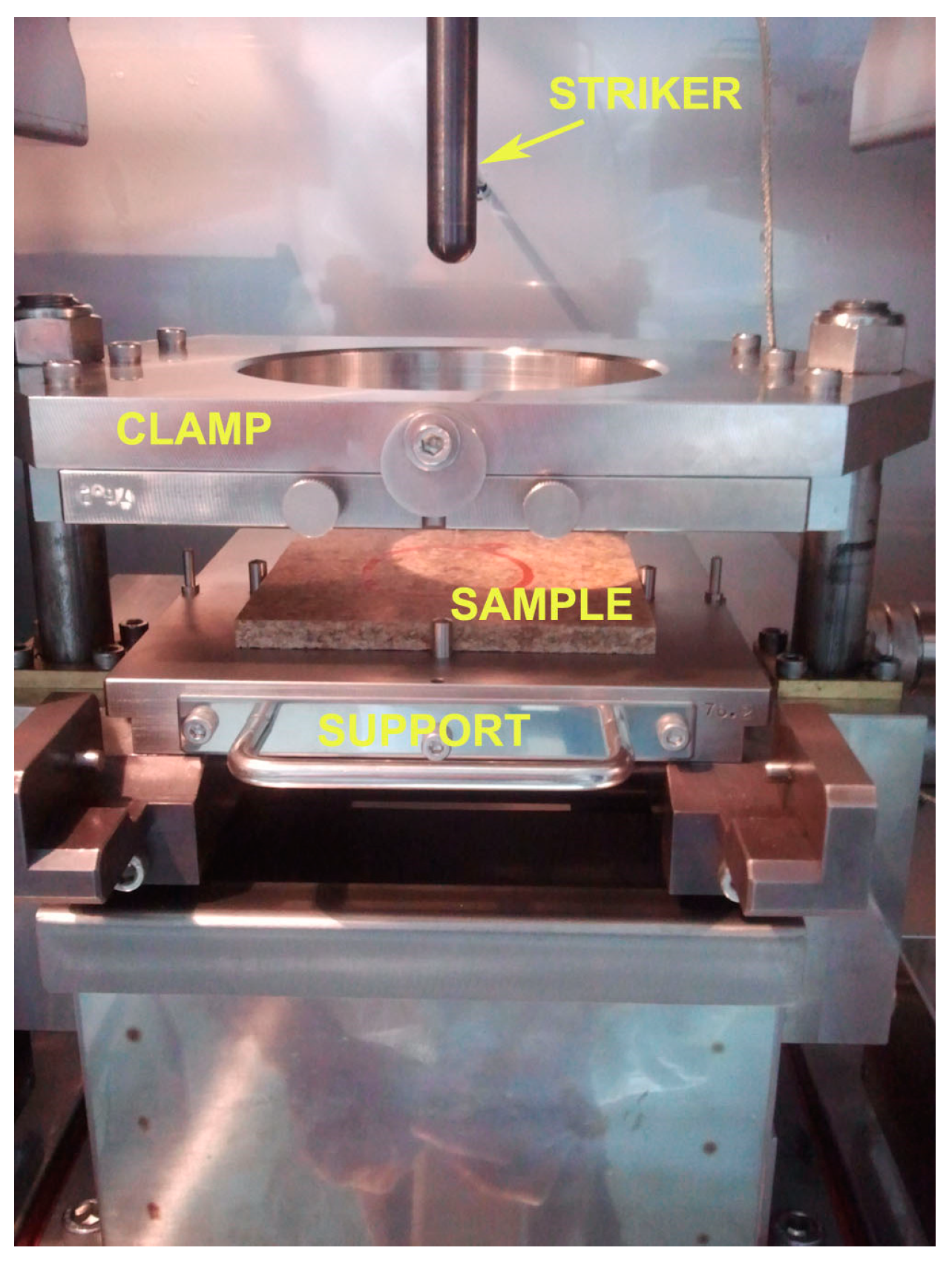
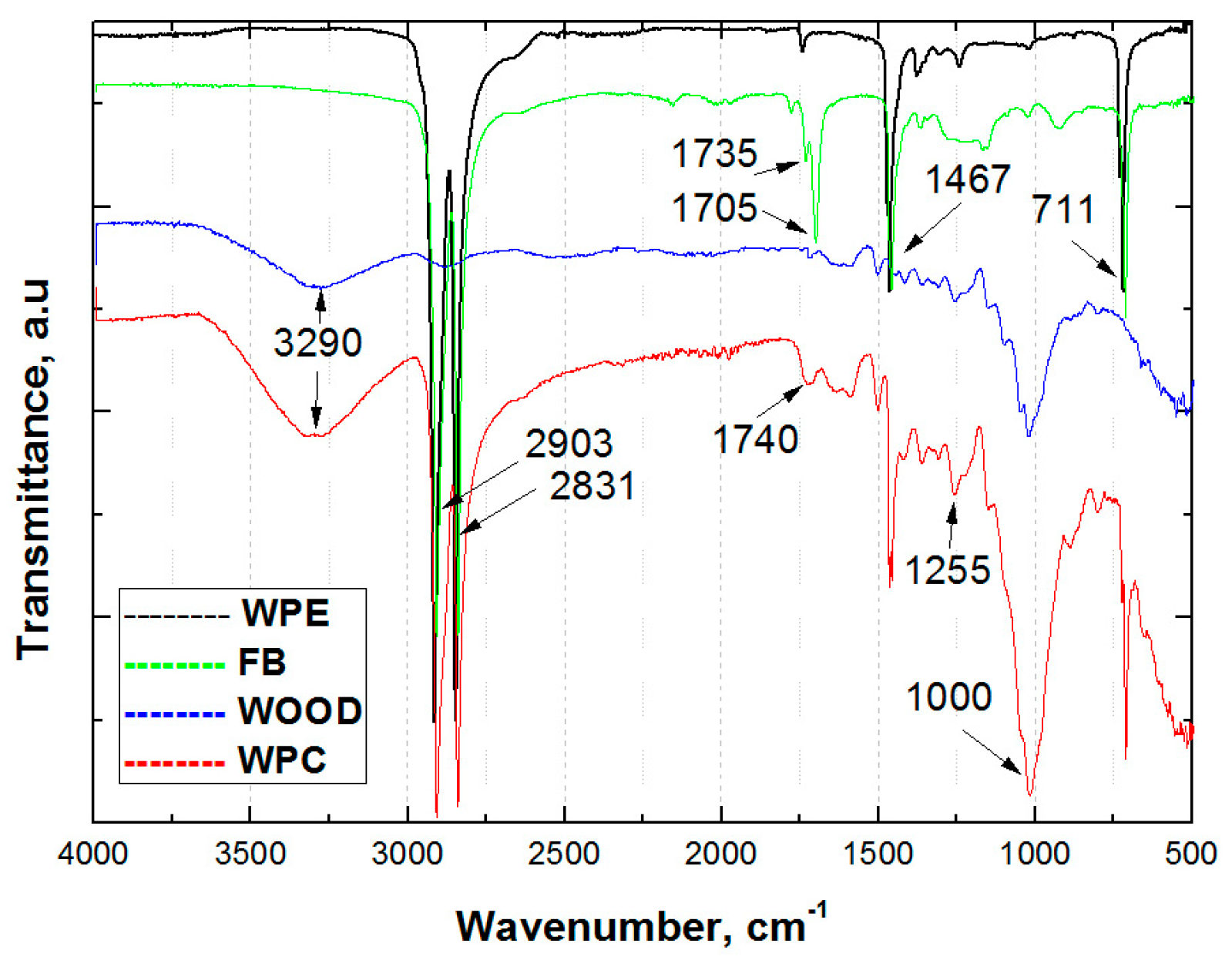
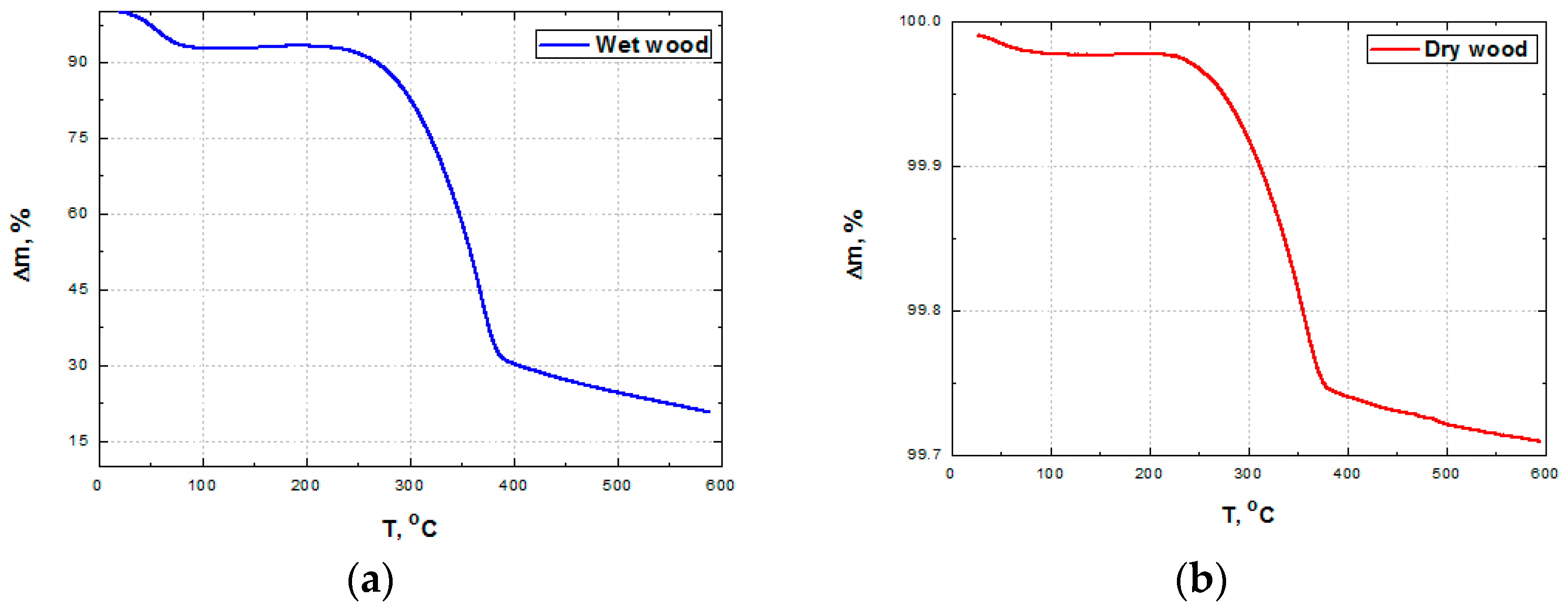
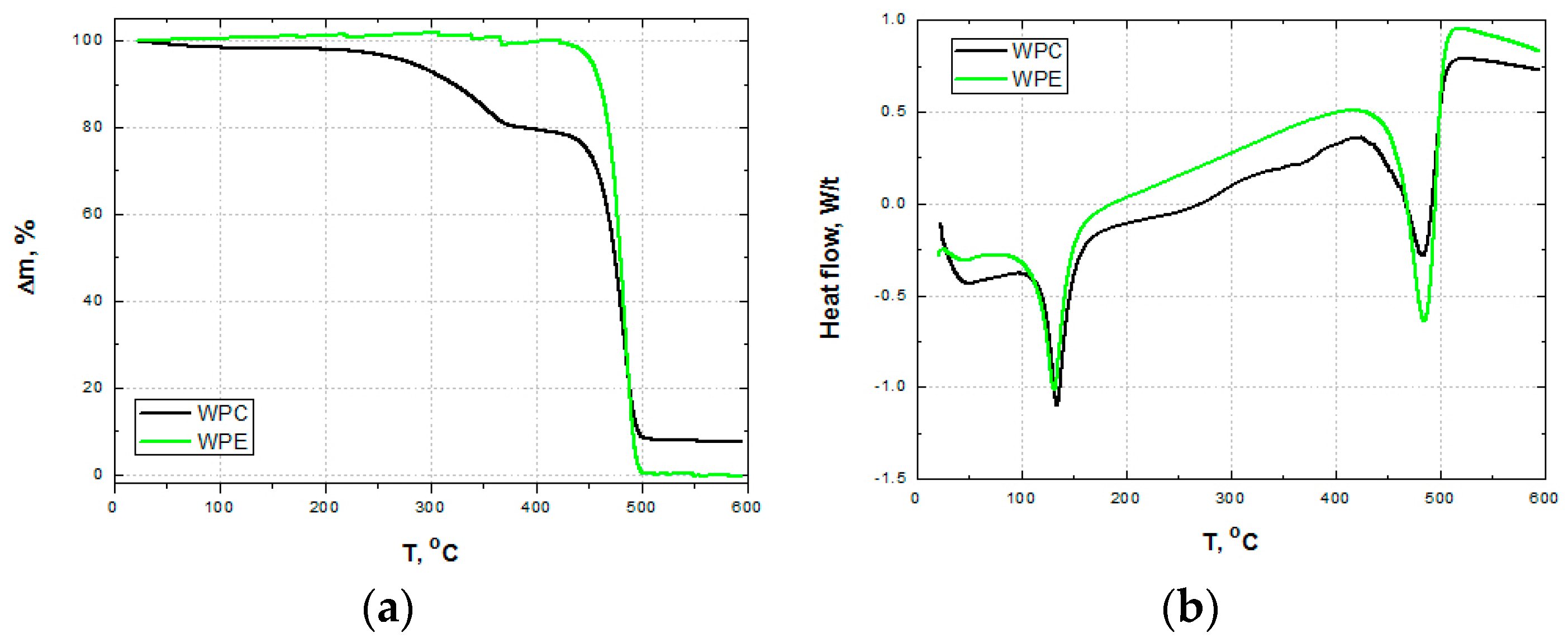
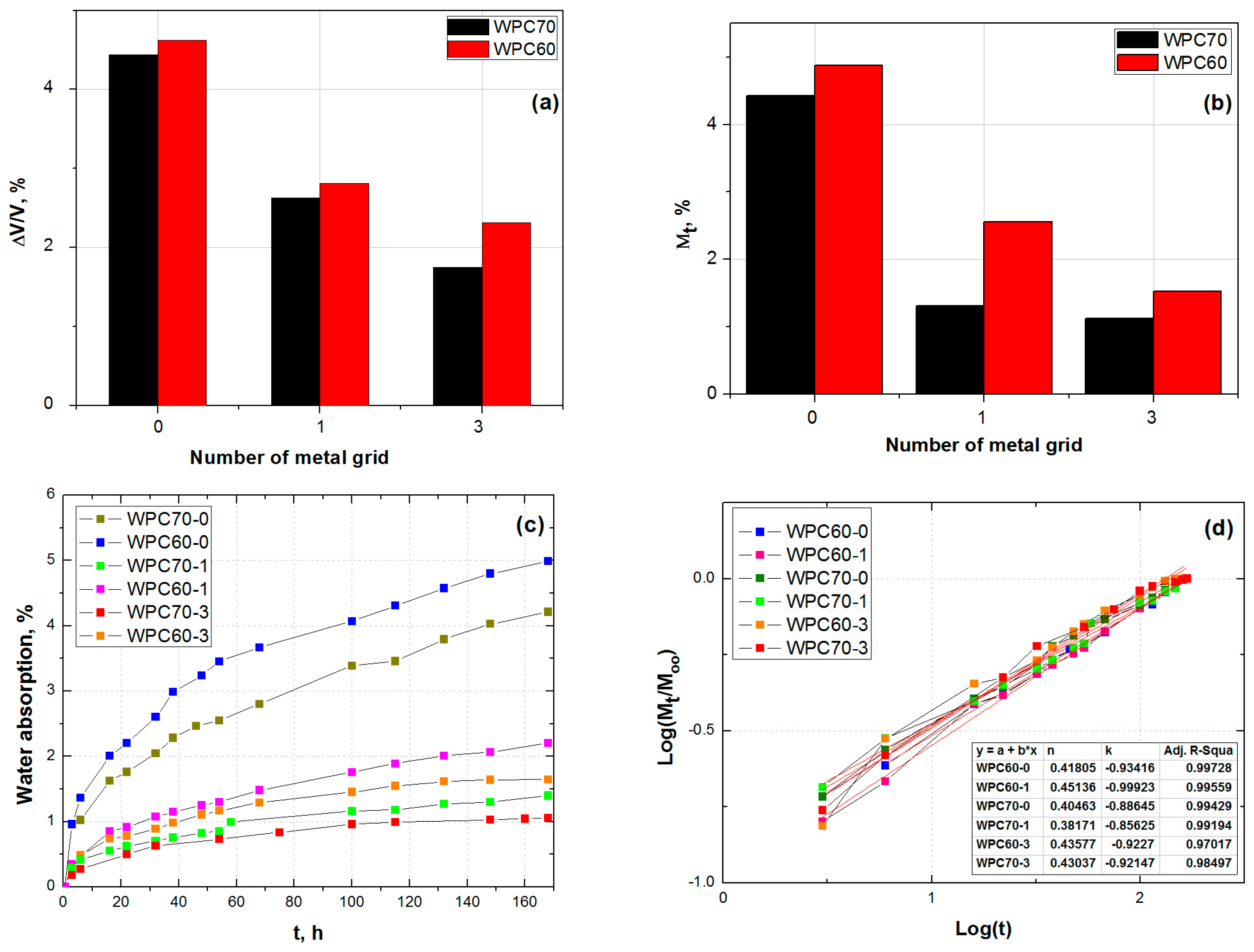
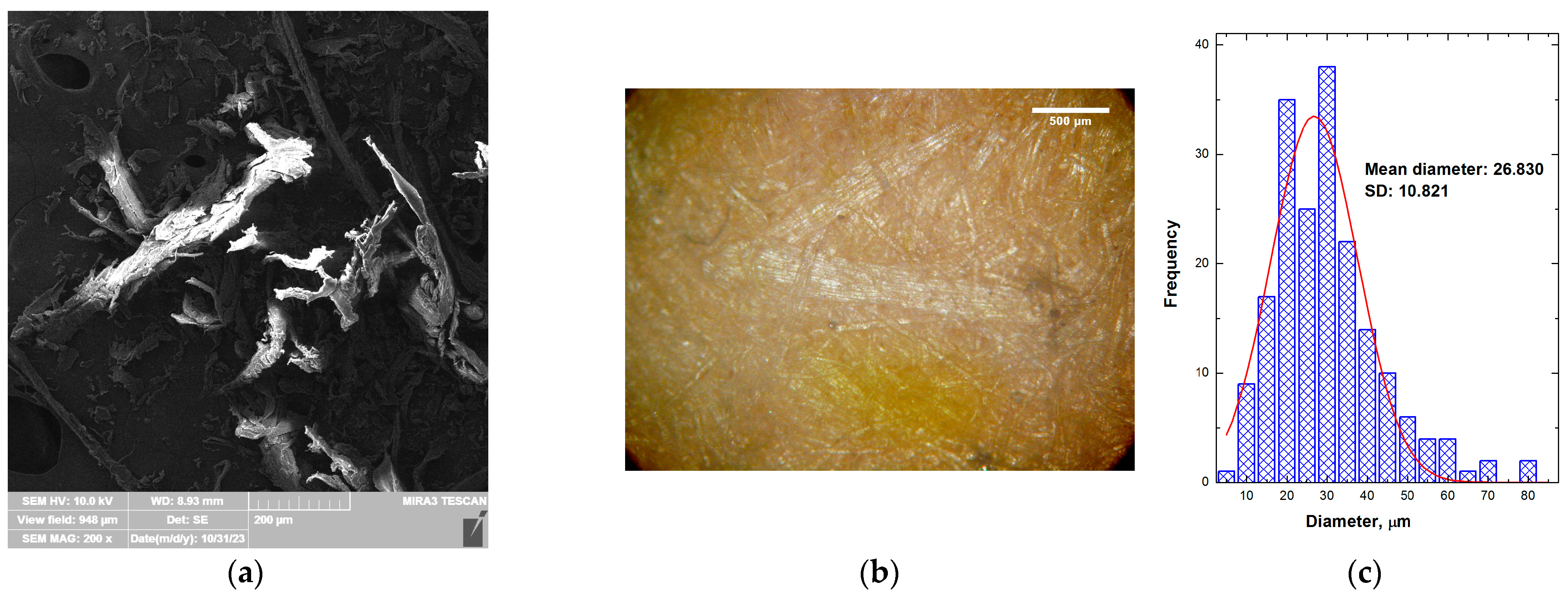


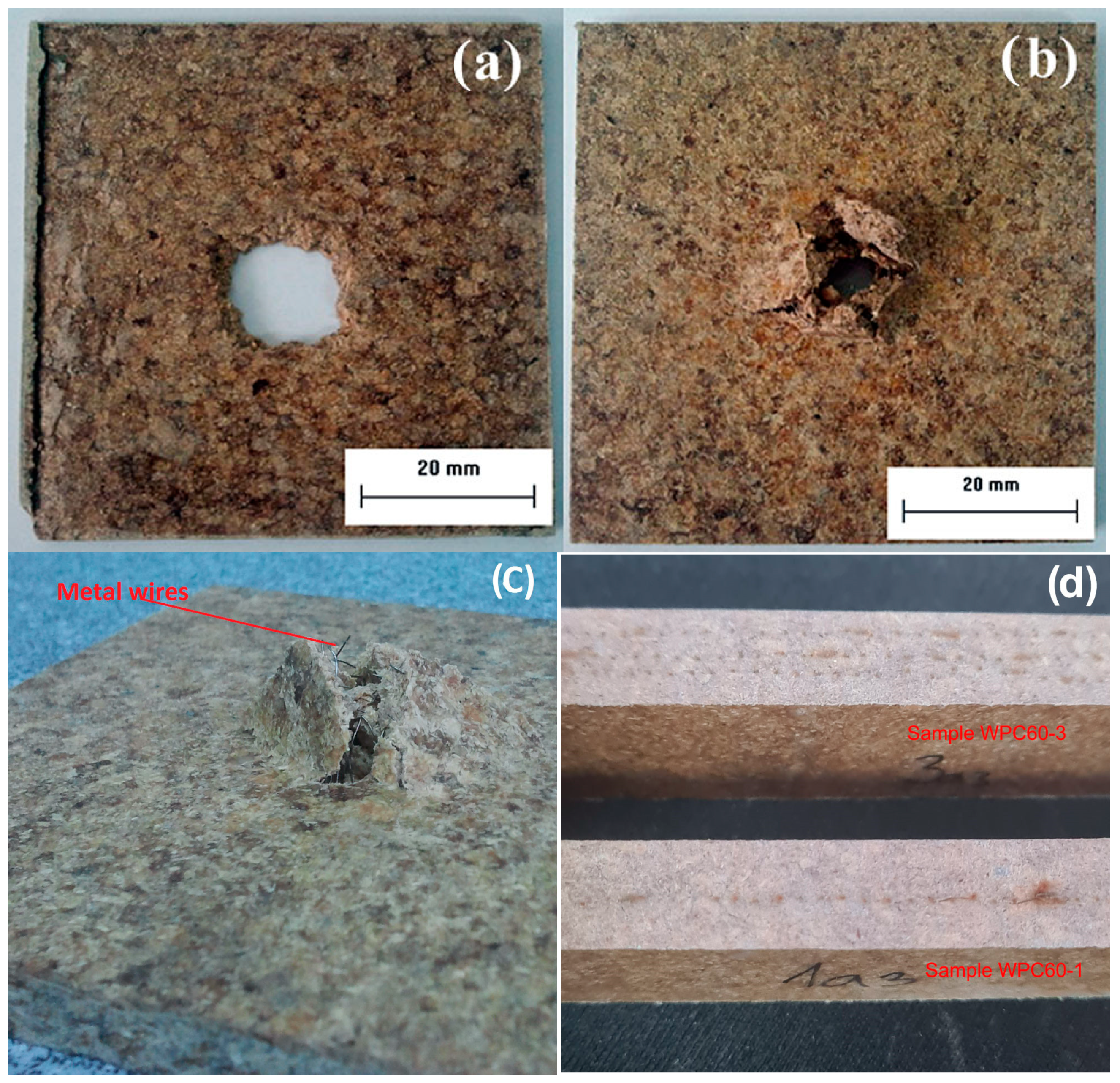
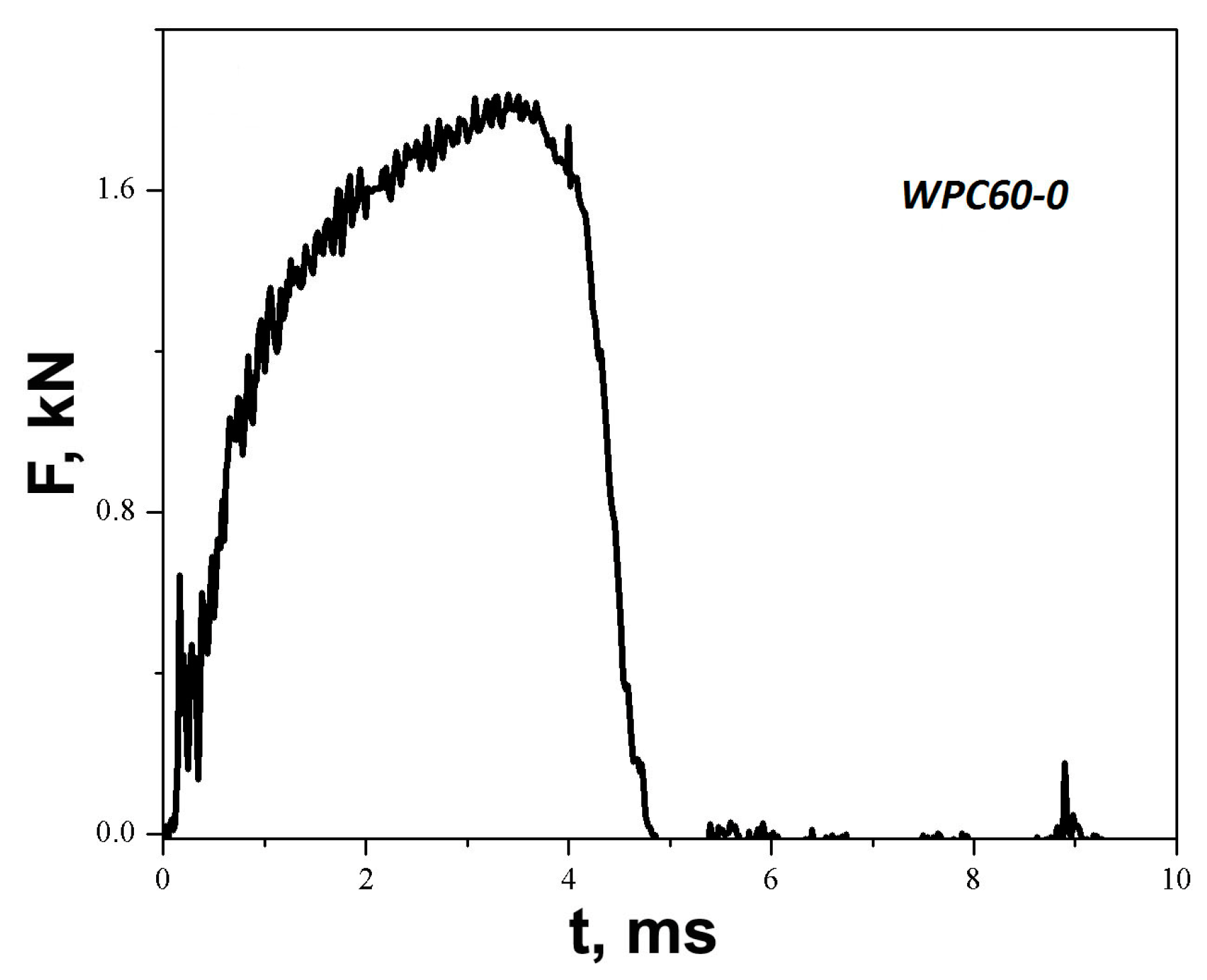


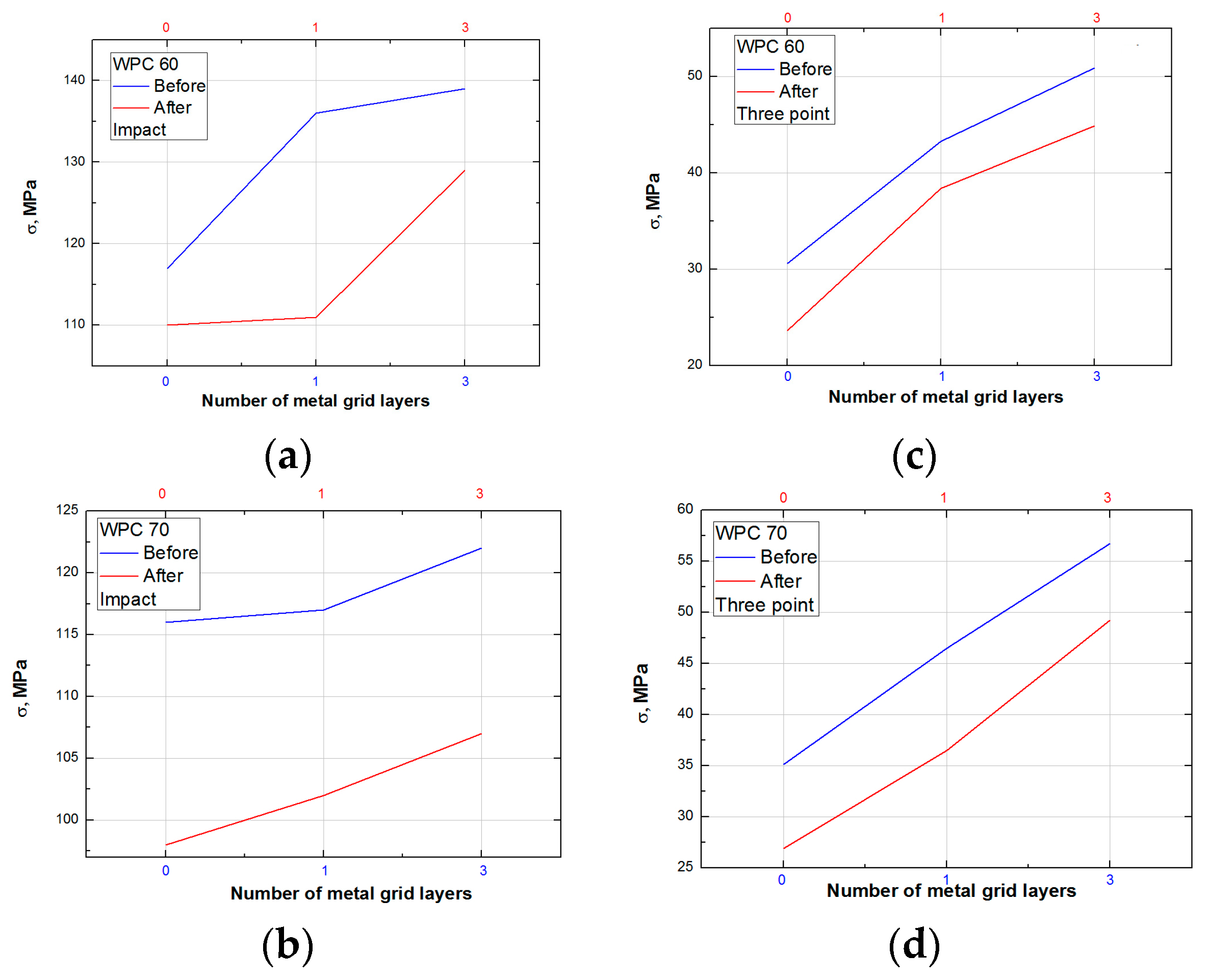
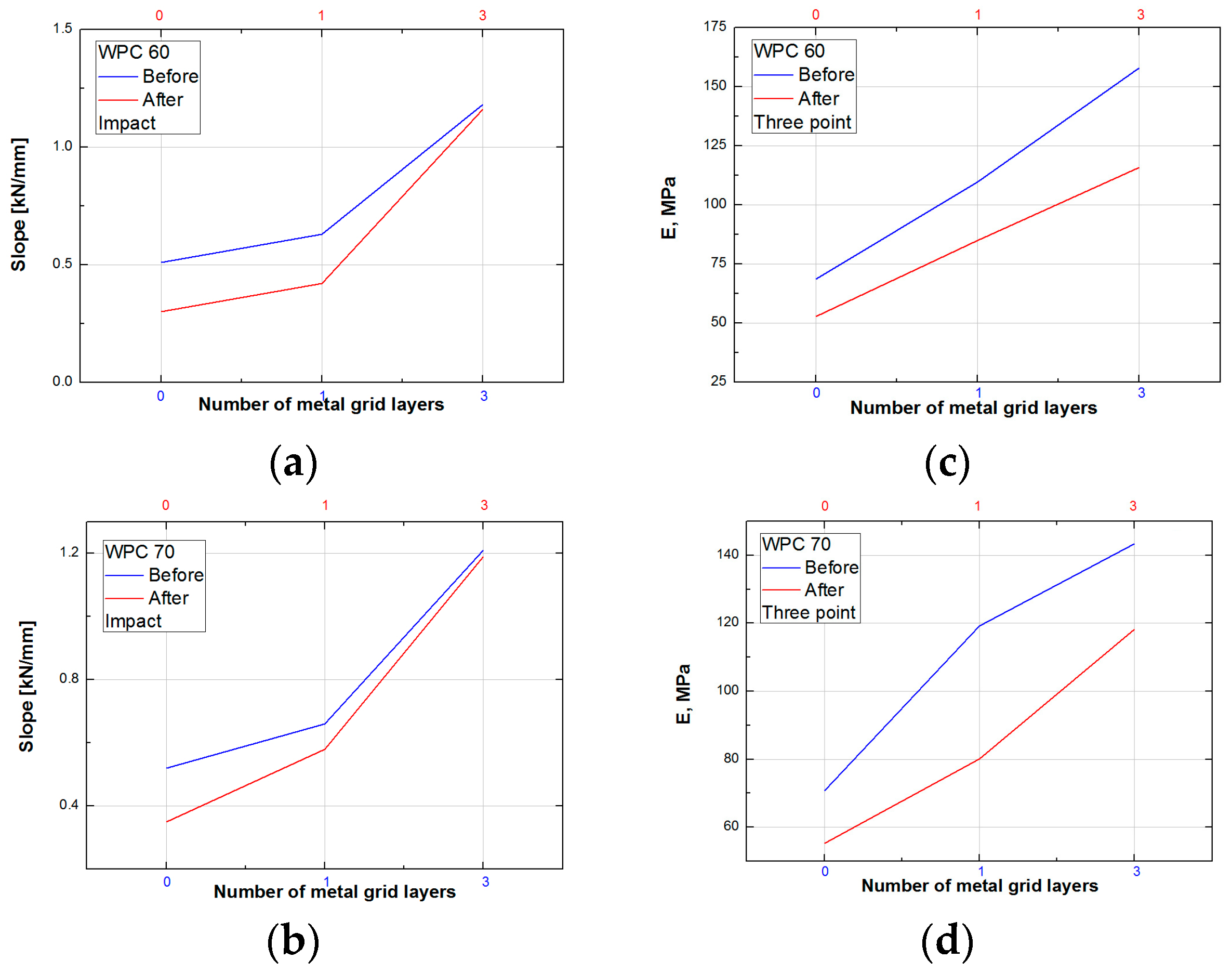
| SAMPLE | WPC60-0 | WPC60-1 | WPC60-3 | WPC60-0a | WPC60-1a | WPC60-3a |
| No of grid | 0 | 1 | 3 | 0 | 1 | 3 |
| mgrid, (g) | 0 | 10 | 30 | 0 | 10 | 30 |
| xWPE, (%) | 60 | 60 | 60 | 60 | 60 | 60 |
| xwood, (%) | 40 | 40 | 40 | 40 | 40 | 40 |
| mWPC, (g) | 400 | 390 | 370 | 400 | 390 | 370 |
| xWPC (%) | 100 | 97.5 | 92.5 | 100 | 97.5 | 92.5 |
| SAMPLE | WPC70-0 | WPC70-1 | WPC70-3 | WPC70-0a | WPC70-1a | WPC70-3a |
| No of grid | 0 | 1 | 3 | 0 | 1 | 3 |
| mgrid, (g) | 0 | 10 | 30 | 0 | 10 | 30 |
| xWPE, (%) | 70 | 70 | 70 | 70 | 70 | 70 |
| xwood, (%) | 30 | 30 | 30 | 30 | 30 | 30 |
| mWPC, (g) | 400 | 390 | 370 | 400 | 390 | 370 |
| xWPC (%) | 100 | 97.5 | 92.5 | 100 | 97.5 | 92.5 |
| Sample | , (MPa) | Einit, (kJ/m) | Etot, (kJ/m) | DI | Slope, (KN/mm) | ||||
|---|---|---|---|---|---|---|---|---|---|
| WPC60-0 | 117 | (1.901) | 1.29 | (0.026) | 1.76 | (0.008) | 0.27 | 0.51 | (0.022) |
| WPC60-1 | 136 | (2.070) | 1.57 | (0.013) | 2.32 | (0.022) | 0.31 | 0.63 | (0.026) |
| WPC60-3 | 139 | (1.636) | 2.06 | (0.024) | 3.12 | (0.109) | 0.49 | 1.18 | (0.015) |
| WPC60-0a | 110 | (1.108) | 0.67 | (0.030) | 0.88 | (0.019) | 0.24 | 0.30 | (0.021) |
| WPC60-1a | 111 | (1.302) | 1.67 | (0.034) | 2.10 | (0.148) | 0.20 | 0.42 | (0.027) |
| WPC60-3a | 129 | (1.347) | 1.43 | (0.009) | 3.10 | (0.152) | 0.54 | 1.16 | (0.017) |
| Sample | , (MPa) | Einit, (kJ/m) | Etot, (kJ/m) | DI | Slope, (KN/mm) | ||||
|---|---|---|---|---|---|---|---|---|---|
| WPC70-0 | 116 | (1.246) | 1.23 | (0.019) | 1.82 | (0.008) | 0.36 | 0.52 | (0.021) |
| WPC70-1 | 117 | (0.901) | 1.15 | (0.008) | 1.99 | (0.019) | 0.37 | 0.66 | (0.019) |
| WPC70-3 | 122 | (1.961) | 0.93 | (0.016) | 2.68 | (0.021) | 0.65 | 1.21 | (0.013) |
| WPC70-0a | 98 | (0.830) | 1.17 | (0.015) | 1.72 | (0.009) | 0.46 | 0.35 | (0.028) |
| WPC70-1a | 102 | (0.412) | 0.93 | (0.019) | 1.86 | (0.011) | 0.41 | 0.58 | (0.031) |
| WPC70-3a | 107 | (0.716) | 0.92 | (0.023) | 1.99 | (0.011) | 0.54 | 1.19 | (0.023) |
| Sample | F, (N) | , (MPa) | E, (MPa) | |||
|---|---|---|---|---|---|---|
| WPC60-0 | 268.7 | (0.564) | 30.6 | (0.329) | 68.6 | (0.502) |
| WPC60-1 | 372.1 | (0.688) | 43.3 | (0.410) | 109.7 | (0.422) |
| WPC60-3 | 446.2 | (0.450) | 50.9 | (0.526) | 157.8 | (0.370) |
| WPC60-0a | 218.4 | (0.339) | 23.6 | (0.492) | 52.8 | (0.541) |
| WPC60-1a | 329.3 | (0.358) | 38.4 | (0.305) | 84.9 | (0.311) |
| WPC60-3a | 390.3 | (0.268) | 44.9 | (0.259) | 115.7 | (0.274) |
| Sample | F, (N) | E, (MPa) | ||||
|---|---|---|---|---|---|---|
| WPC70-0 | 275.4 | (0.406) | 35.1 | (0.313) | 70.8 | (0.502) |
| WPC70-1 | 379.2 | (0.568) | 46.5 | (0.557) | 119.2 | (0.482) |
| WPC70-3 | 454.2 | (0.316) | 56.7 | (0.432) | 143.4 | (0.286) |
| WPC70-0a | 222.1 | (0.661) | 26.9 | (0.297) | 55.2 | (0.453) |
| WPC70-1a | 322.7 | (0.466) | 36.5 | (0.240) | 80.1 | (0.327) |
| WPC70-3a | 399.6 | (0.469) | 49.2 | (0.472) | 118.2 | (0.291) |
Disclaimer/Publisher’s Note: The statements, opinions and data contained in all publications are solely those of the individual author(s) and contributor(s) and not of MDPI and/or the editor(s). MDPI and/or the editor(s) disclaim responsibility for any injury to people or property resulting from any ideas, methods, instructions or products referred to in the content. |
© 2023 by the authors. Licensee MDPI, Basel, Switzerland. This article is an open access article distributed under the terms and conditions of the Creative Commons Attribution (CC BY) license (https://creativecommons.org/licenses/by/4.0/).
Share and Cite
Perišić, S.; Kalevski, K.; Grujić, A.; Nedeljković, D.; Stajić-Trošić, J.; Radojević, V. Effect of Moisture on the Mechanical Properties of Wood–Plastic Composites Hybridized with Metal Grid Layers. Polymers 2023, 15, 4705. https://doi.org/10.3390/polym15244705
Perišić S, Kalevski K, Grujić A, Nedeljković D, Stajić-Trošić J, Radojević V. Effect of Moisture on the Mechanical Properties of Wood–Plastic Composites Hybridized with Metal Grid Layers. Polymers. 2023; 15(24):4705. https://doi.org/10.3390/polym15244705
Chicago/Turabian StylePerišić, Srdjan, Katarina Kalevski, Aleksandar Grujić, Dragutin Nedeljković, Jasna Stajić-Trošić, and Vesna Radojević. 2023. "Effect of Moisture on the Mechanical Properties of Wood–Plastic Composites Hybridized with Metal Grid Layers" Polymers 15, no. 24: 4705. https://doi.org/10.3390/polym15244705
APA StylePerišić, S., Kalevski, K., Grujić, A., Nedeljković, D., Stajić-Trošić, J., & Radojević, V. (2023). Effect of Moisture on the Mechanical Properties of Wood–Plastic Composites Hybridized with Metal Grid Layers. Polymers, 15(24), 4705. https://doi.org/10.3390/polym15244705








